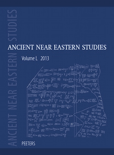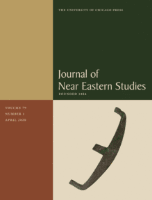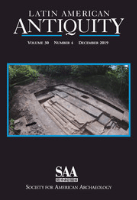
Bulletin of the American Society of Overseas Research
Scope & Guideline
Bridging gaps in knowledge with innovative research and discourse.
Introduction
Aims and Scopes
- Archaeological Research and Methodology:
The journal emphasizes innovative archaeological techniques and methodologies, showcasing studies that utilize modern technologies and theoretical frameworks to interpret archaeological findings. - Interdisciplinary Approaches:
A core focus is on interdisciplinary work that combines archaeology with history, anthropology, and art history, facilitating a comprehensive understanding of ancient cultures and their complexities. - Cultural and Historical Contexts:
The journal aims to explore the cultural, social, and political dynamics of ancient societies, contributing to the broader understanding of human history and cultural development. - Regional Studies:
Special attention is given to regional studies, particularly those focused on the Near East, Mediterranean, and surrounding areas, highlighting local characteristics and broader interactions. - Artifact Analysis and Interpretation:
The journal publishes works that analyze artifacts, inscriptions, and architectural remains, providing insights into ancient technologies, economies, and belief systems.
Trending and Emerging
- Intercultural Interactions and Exchanges:
There is a notable increase in research that examines the interactions between different cultures, particularly in the context of trade, migration, and conflict, emphasizing the interconnectedness of ancient societies. - Technological Advances in Archaeology:
The integration of advanced technologies, such as digital imaging, GIS, and remote sensing, is increasingly prevalent in research, allowing for innovative methodologies in archaeological analysis. - Re-evaluation of Historical Narratives:
Recent publications are focusing on re-evaluating established historical narratives through new archaeological evidence, challenging previous assumptions and providing fresh perspectives on ancient histories. - Environmental Archaeology:
Research exploring the relationship between ancient societies and their environments, including studies on climate change impacts, agricultural practices, and resource management, is gaining importance. - Social and Gender Dynamics in Ancient Societies:
An emerging focus is on understanding the roles and representations of gender and social structures in ancient cultures, providing a more inclusive view of historical narratives.
Declining or Waning
- Traditional Historical Narratives:
There seems to be a reduced emphasis on traditional historical narratives that do not incorporate new archaeological findings or interdisciplinary perspectives, as scholars move towards more nuanced interpretations. - Single-Culture Studies:
Research that solely focuses on single cultures without considering broader regional interactions or influences is becoming less prevalent, as interdisciplinary and comparative studies gain traction. - Generalized Artifact Studies:
Studies that provide generic descriptions of artifacts without contextual analysis or implications for cultural practices are increasingly viewed as less impactful, leading to a decline in such publications. - Purely Descriptive Archaeological Reports:
Papers that focus solely on descriptive reports of excavations are being overshadowed by studies that incorporate theoretical frameworks and broader implications for understanding ancient societies.
Similar Journals

Ancient Near Eastern Studies
Advancing Scholarship in the Heart of Ancient HistoryAncient Near Eastern Studies, published by PEETERS in Belgium, is a distinguished journal dedicated to the exploration and scholarship of the rich cultural and historical tapestry of the ancient Near East. With a focus on interdisciplinary research, this journal invites contributions across various fields including Archeology, History, Classics, Literature and Literary Theory, and Visual Arts and Performing Arts. As evidenced by its robust performance in the 2023 category quartiles, ranking Q1 in Classics and Q2 in History, this journal is recognized for its academic rigor and relevance, making it an integral platform for researchers, professionals, and students alike. Although currently not open access, it provides indispensable insights into research trends and theoretical frameworks that advance our understanding of ancient civilizations. With its ISSN 1378-4641 and E-ISSN 1783-1326, Ancient Near Eastern Studies continues to foster scholarly communication and engagement in this vital area of human history.

Lucentum
Illuminating the Past, Inspiring the FutureLucentum is a distinguished open-access journal published by Universidad de Alicante, focusing on the interdisciplinary fields of Archeology, History, and Paleontology. Since its inception in 1982, it has established itself as a vital platform for scholars and researchers to disseminate their findings, contributing significantly to the academic landscape in Spain and beyond. The journal's notable rankings, including Q1 status in History and Q2 in Archeology, reflect its commitment to high-quality scholarship and rigorous peer review. With an impressive impact factor and recognition in Scopus, Lucentum serves as an essential resource for professionals, students, and historians, fostering a deeper understanding of cultural and historical contexts through a wealth of interdisciplinary research. The journal continues to embrace open access, ensuring that critical knowledge is freely available to the global research community.

Cuadernos de Prehistoria y Arqueologia-Universidad Autonoma de Madrid
Connecting Researchers to the Rich Tapestry of HistoryCuadernos de Prehistoria y Arqueologia-Universidad Autonoma de Madrid is a distinguished academic journal dedicated to the fields of archaeology and prehistory, published by the Universidad Autonoma de Madrid, Departamento de Prehistoria y Arqueología. With an ISSN of 0211-1608, this journal plays a crucial role in disseminating significant research findings and theoretical advancements within these domains. Recognized for its scholarly excellence, it holds impressive quartile rankings in 2023, including Q2 in Archaeology and Q1 in History, reflecting its high impact within the academic community. While currently not an open-access publication, Cuadernos de Prehistoria y Arqueologia provides valuable insights to researchers, professionals, and students engaged in the exploration of human history and cultural heritage from 2018 to 2024 and beyond. With a commitment to fostering interdisciplinary dialogue, this journal serves as an essential platform for innovative studies and comprehensive reviews, contributing to the advancement of knowledge in archaeology and prehistory.

Ancient Asia-Journal of the Society of South Asian Archaeology
Connecting Scholars to the Wonders of Ancient AsiaAncient Asia - Journal of the Society of South Asian Archaeology, published by ARF India, stands as a pivotal resource for the exploration and dissemination of archaeological research focused on the rich history and culture of South Asia. Since its inception as an Open Access journal in 2006, it has become an essential platform for scholars and enthusiasts alike, boasting an impressive range of quartile rankings across multiple disciplines, including Anthropology, Archaeology, History, and Visual Arts. With expansion into various indexed categories and consistent dissemination of impactful research common to this highly diverse field, Ancient Asia aims to foster interdisciplinary dialogue, facilitate collaboration among researchers, and enhance the global understanding of ancient civilizations within the region. By embracing an inclusive access model, the journal encourages wide readership and engagement, positioning itself as a key player for students, professionals, and academics interested in delving into the archaeological marvels of South Asia.

Opuscula-Annual of the Swedish Institutes at Athens and Rome
Illuminating the Intersections of History and the Visual ArtsOpuscula - Annual of the Swedish Institutes at Athens and Rome is a distinguished academic journal dedicated to advancing the field of archaeology, classics, history, and the visual arts. Published by the Editorial Committee Swedish Institute Athens & Rome, this journal fosters interdisciplinary dialogue and research, contributing valuable scholarship to these interconnected domains. With an impressive impact factor reflected in the authoritative Scopus rankings, it holds a commendable Q2 ranking in Archaeology and Arts and Humanities and achieves Q1 status in Classics, History, and Visual Arts and Performing Arts. Although Open Access options are not specified, the journal remains a critical resource for scholars seeking peer-reviewed articles that cover a range of topics pertinent to the rich legacies of the Mediterranean. By bridging historical inquiry with contemporary analysis, Opuscula serves as an essential platform for researchers, professionals, and students, ensuring the ongoing vitality of academic discourse in these vital fields.

Stratum Plus
Exploring the Depths of Humanity and TimeStratum Plus, published by HIGH ANTHROPOLOGICAL SCH UNIV, is a distinguished academic journal based in Moldova that focuses on the fields of Anthropology, Archeology, and History. With an impressive impact factor reflecting its stature—ranked in the Q2 category for both Anthropology and Archeology, and Q1 for Archeology in the arts and humanities—this journal is a vital resource for scholars, professionals, and students alike. The journal's comprehensive scope encompasses a wide array of interdisciplinary studies, making it a beacon for innovative research and critical discourse within these disciplines. Since its inception in 2014, Stratum Plus has strived to foster academic excellence and knowledge dissemination, thus playing a crucial role in shaping contemporary anthropological and archaeological thought. While currently not available as Open Access, the journal maintains a strong online presence, with access options available through institutional subscriptions. Located at ZIMBRULUI 10A ST, KISHINEV MD-2024, MOLDOVA, Stratum Plus invites contributors and readers to engage with cutting-edge research that continues to enrich the global academic community.

Ancient Civilizations from Scythia to Siberia
Advancing Knowledge of Eurasia's Historical HeritageAncient Civilizations from Scythia to Siberia, published by BRILL, is a pivotal journal dedicated to the exploration and scholarly analysis of ancient cultures in Eurasia, with a focus spanning from the Scythian tribes to the Siberian territories. With an ISSN of 0929-077X and an E-ISSN of 1570-0577, this journal plays a significant role in the fields of Archeology, Classics, and History, holding esteemed rankings in Q3 and Q1 categories, thus affirming its status in the academic community. Covering a wide temporal range from 1995 to 2024, the journal aims to provide a comprehensive platform for researchers and students to disseminate their findings and foster collaborative discourse. With impact rankings in the 86th and 75th percentiles for Classics and History, respectively, it is recognized for its high-quality contributions that advance knowledge in these areas. Although currently not an open-access journal, it offers various options for accessing its rich content. By bridging gaps in historical understanding and engaging with the complexities of ancient societies, Ancient Civilizations from Scythia to Siberia remains an essential resource for those passionate about uncovering the narratives of our past.

Bulletin de la Societe Prehistorique Francaise
Fostering Scholarly Dialogue on Our Ancient HeritageBulletin de la Societe Prehistorique Francaise (ISSN: 0249-7638; E-ISSN: 1760-7361), published by the SOCIETE PREHISTORIQUE FRANCAISE, stands as a pivotal journal within the domain of archaeology, particularly emphasizing prehistoric studies. With its classification in the Q2 quartile of both the arts and humanities as well as social sciences in archaeology, the journal positions itself among the top 25% of publications in these categories as of 2023. This distinguished ranking reflects its significant contribution to the field, providing researchers, professionals, and students with critical insights and innovative methodologies related to prehistoric research. Although open access options are currently unavailable, the journal is committed to fostering academic discourse and sharing knowledge that influences contemporary archaeological practices. As a member of the elite academic community, Bulletin de la Societe Prehistorique Francaise is highly regarded for its rigorous peer-review process and dedication to the advancement of archaeology, making it an essential resource for anyone invested in understanding our historical roots.

JOURNAL OF NEAR EASTERN STUDIES
Exploring the Rich Tapestry of Near Eastern HeritageJournal of Near Eastern Studies (ISSN: 0022-2968; E-ISSN: 1545-6978), published by University of Chicago Press, stands as a cornerstone of academic discourse in the fields of Archaeology, Cultural Studies, and Linguistics and Language. With a prestigious track record that has evolved since its inception and spanning converged publication years from 1968 to 2024, this journal holds an impressive Q1 ranking in Cultural Studies and Linguistics and Language, and a solid Q2 ranking in Archaeology and Arts and Humanities as of 2023. Despite not offering open access, it is widely regarded for its rigorous peer-reviewed articles that contribute significantly to the understanding of Near Eastern history, culture, and languages. The journal's sustained recognition in Scopus rankings, including a notable 30th rank out of 173 in Arts and Humanities, ensures it remains an essential resource for researchers, academics, and students dedicated to exploring the rich tapestry of the Near East. With its base in Chicago, USA, the Journal of Near Eastern Studies continues to foster interdisciplinary collaboration and scholarly excellence.

LATIN AMERICAN ANTIQUITY
Illuminating the Past: A Gateway to Latin America's Ancient CivilizationsLATIN AMERICAN ANTIQUITY is a prestigious journal published by Cambridge University Press, focusing on the archaeology and history of Latin America. With an impressive impact factor reflecting its critical role in the academic community, this journal exemplifies excellence in research, landing in Q1 across multiple categories, including Archaeology and History, as per the 2023 category quartiles. The journal's scope covers a broad range of topics related to pre-Columbian cultures, ancient civilizations, and historical developments, making it essential reading for researchers, professionals, and students keen on exploring the rich tapestry of Latin American heritage. Although it is not an open-access publication, LATIN AMERICAN ANTIQUITY remains a vital resource for those dedicated to advancing knowledge in this dynamic field. With its commitment to scholarly rigor and a strong ranking in Scopus, it serves as a cornerstone for academic dialogue and investigation.